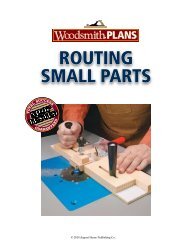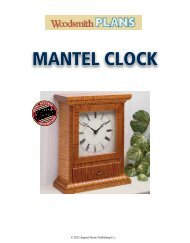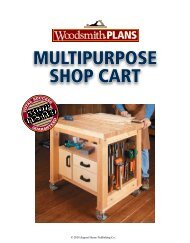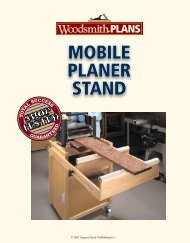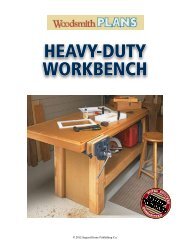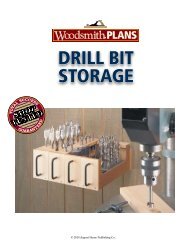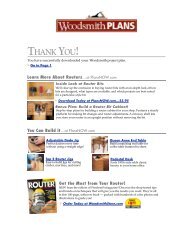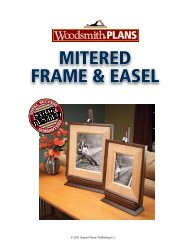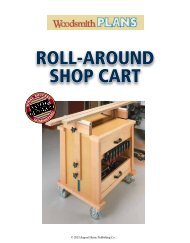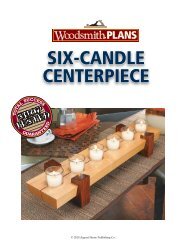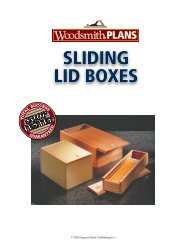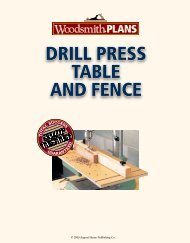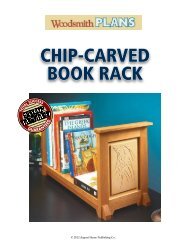KNOCK-DOWN WALL SHELF - Woodsmith Shop
KNOCK-DOWN WALL SHELF - Woodsmith Shop
KNOCK-DOWN WALL SHELF - Woodsmith Shop
- No tags were found...
Create successful ePaper yourself
Turn your PDF publications into a flip-book with our unique Google optimized e-Paper software.
When making the wedges, startby cutting them a little oversized.That way, you can pare them downwith a chisel until they slide intoplace. You’re aiming for a tight fitwithout having the round part of thewedge bottom out against the tenon(left photo on page 1).Cleats. The last parts to make area pair of cleats. These are simplyglued to the underside of the topand bottom shelves, flush with theback edges. Although the cleats doadd a little strength to the shelves,their real purpose is to provide aplace to screw the shelf to the wall.Assembly. The last step is to puteverything together. The fourshelves are captured in betweenthe sides without any glue. Thenthe wedges are slipped in place tohold everything together. It’s best topush them in by hand, rather thanusing a mallet. If you use too muchforce, you’re likely to split the woodat the end of the through tenons.how-to: making the mortisesCut Notches. Using a dado blade and the ripfence as a stop, cut matching notches in thepieces that make up each side of the wall shelf.Glue Up the Sides. Waxed hardwood keys help tokeep the mortise notches aligned while gluing up thesides of the wall shelf.2 <strong>Woodsmith</strong><strong>Shop</strong>.com © 2011 August Home Publishing Co. All Rights Reserved.
Tips FromOur <strong>Shop</strong>Wedged Mortise & TenonLearn the secrets to making this traditional woodworking joint.You don’t have to be a woodworker to understandhow a wedged mortise and tenon jointworks — one look is all it takes. The tenon passesclean through the mortise and is locked in place by asimple tapered wedge (drawing at left).But making a wedged mortise and tenon joint canbe a little more complicated. Because these jointsdon’t rely on glue for their strength, it’s all the moreimportant to make sure the pieces fit together properly.Fortunately, this isn’t all that difficult.Here, I’ll show you how I made the joints for theknock-down wall shelf. The procedure is similar formost other wedged mortise and tenon joinery. Soyou can apply the technique timeand time again.Mortises. The first step to makingthis joint is to create the mortise.I made the mortises for the wallshelf on the table saw, as shown inthe box on page 3. No matter whatmethod you use to do this, theimportant thing is to keep themas square and accurate as possible.Otherwise, you’ll end up withnoticeable gaps around the tenons.3 <strong>Woodsmith</strong><strong>Shop</strong>.com © 2011 August Home Publishing Co. All Rights Reserved.
Tenons. Once the mortises arecomplete, you can start on thetenons. To make the tenons, Ibegan with the cheek cuts, asshown in Figure 1. The goal hereis to establish the thickness of thetenon by removing a small amountof material from each face of theworkpiece. To do this, I used asimple tenon jig to hold the workpiecewhile making the cuts.Then to create the shoulders ofthe tenons, I made multiple passesto remove the waste from thesides of the tenon (Figure 2). Anauxiliary fence attached to the mitergauge helps support the workpiece.Wedge Mortises. After you’ve cut allthe tenons, you’re ready to start makingthe mortises for the wedges.There’s just one thing to keepin mind when laying out thesemortises. You want to locate themso they end up slightly behind theouter face of the side pieces of thewall shelf, as shown in the detaildrawing on the previous page. Thisallows the shelves to be drawn uptight against the sides when thewedges are seated.If you take a look at the detaildrawing at right, you’ll see that eachmortise is tapered on one face. Thisallows the wedge to lock securelyin place without any glue. But it’seasier to start by making square,straight-walled mortises. I did thisby drilling outthe waste andthen squaringup the sides witha chisel, as illustratedat right.To taper themortises, I used a chisel to shave alittle off the outer face of each mortise.Slice away the material at anangle, taking light cuts until you’vepared back the top edge of the mortiseby 1 ⁄ 16". Finally, you can makeand fit the wedges (box below).12hold it together: wedgesWhen it comes to making the wedgefor a mortise and tenon joint, theimportant thing is for the taper ofthe wedge to match the mortiseso it seats properly. I’ve found thatthe best way to do this is to startby cutting the wedge slightly widerthan necessary. Then with a sharpchisel, you can shave off material asneeded to fine tune the fit.To make the wedges for theknock-down shelf, I started with anextra-long blank and cut the taperedfaces on the table saw. Then you cancut the wedges free from the blankwith a band saw or scroll saw.4 <strong>Woodsmith</strong><strong>Shop</strong>.com © 2011 August Home Publishing Co. All Rights Reserved.



